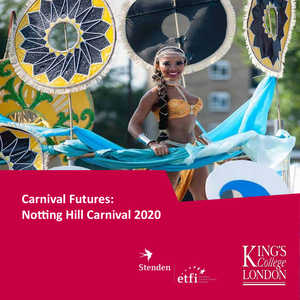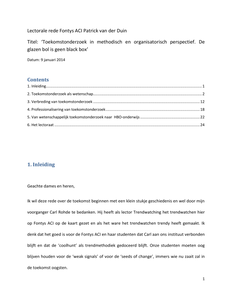De dissertatie "Probing Futures, Acting Today" van Caroline Maessen onderzoekt hoe organisaties alternatieve toekomsten kunnen verbeelden om dagelijkse toekomstvormende praktijken te veranderen teneinde complexe maatschappelijke uitdagingen aan te pakken. Organisaties hebben de neiging door lineair denken hun verbeeldingsvermogen te beperken tot conventionele toekomsten, wat effectieve reacties op problemen zoals klimaatverandering en sociale ongelijkheid belemmert. Het gevolg is dat na de zoveelste heisessie voor visieontwikkeling, er nog steeds niets fundamenteel verandert. Hoe de toekomst zich ontvouwt, tegen de achtergrond van maatschappelijke complexe problemen, gaat vaak voorbij onze collectieve verbeeldingskracht. Organisaties hebben moeite om zich te verbinden met onconventionele toekomsten en acties in het heden daarop af te stemmen. Voor betekenisvolle verandering moeten organisaties navigeren tussen de aantrekkingskracht van inspirerende onconventionele toekomsten en de behoefte aan stabiliteit en controle. Maessen heeft in twee (semi) publieke organisaties onderzocht waarom dit zo lastig is en hoe organisaties daarin ondersteund kunnen worden.
DOCUMENT

Carnival Futures: Notting Hill Carnival 2020 is a King’s Cultural Institute project led by Nicole Ferdinand (Culture, Media and Creative Industries at King’s College London) which sought to engage cultural organisations and other stakeholders in planning for the future of the Notting Hill Carnival. The content of this report is intended as a contribution to current research and to identifying future directions for the development of the Notting Hill Carnival. The material and views expressed are produced by various stakeholders in a series of workshops.
DOCUMENT

In the field of climate change adaptation, the future matters. River futures influence the way adaptation projects are implemented in rivers. In this paper, we challenge the ways in which dominant paradigms and expert claims monopolise the truth concerning policies and designs of river futures, thereby sidelining and delegitimising alternative river futures. So far, limited work has been performed on the power of river futures in the context of climate change adaptation. We conceptualised the power of river futures through river imaginaries, i.e., collectively performed and publicly envisioned reproductions of riverine socionatures mobilised through truth claims of social life and order. Using the Border Meuse project as a case study, a climate change adaptation project in a stretch of the river Meuse in the south of the Netherlands, and a proclaimed success story of climate adaptation in Dutch water management, we elucidated how three river imaginaries (a modern river imaginary, a market-driven imaginary, and an eco-centric river imaginary) merged into an eco-modern river imaginary. Importantly, not only did the river futures merge, but their aligned truth regimes also merged. Thus, we argue that George Orwell’s famous quote, “who controls the past, controls the future: who controls the present, controls the past” can be extended to “who controls the future, controls how we see and act in the present, and how we rediscover the past”.
DOCUMENT
We propose aesthetic engagement as a valuable construct for organisation studies to advance its contribution to organising for sustainability. Aesthetic engagement is defined as a set of material practices that re-engage humans and systems to trigger and accelerate transitions towards regenerative futures. We adopt an aesthetic, practice-based approach to study the emerging field of circular fashion, zooming in on six research projects evolving around bio-based textile design. Our results show that matter needs to matter more in sustainable organising in three key material practices: (1) re-presenting alternative systems, (2) re-imagining affective materialities and (3) re-claiming embodied ethical agency. Matter that reflects new ‘imagined’ realities - whether in artefacts, bodies or socio-material spaces - could greatly support stakeholder engagement and collective identity-building towards transitioning to regenerative futures.
DOCUMENT

Introductie van het lectoraat Futures Research & Trendwatching.
DOCUMENT

The Caribbean Netherlands are dealing with a situation where imported vegetables and fruits are mostly imported and hardly affordable. This leads to consuming unhealthy food and high obesities rates as a consequence. A lack of good agricultural practices with regard to water-smart and nature inclusive agriculture, as well as limited coping capacities to deal with hazards and climate change, results in very limited local production and interest. Initiatives that focused only on agrotechnological solutions for food resilient futures turned out to be ineffective due to a lack of local ownership, which jeopardizes sustainability. Moreover, the 'green' and 'blue' domains are not seen as attractive career perspectives among youth, hampering a bright future for those domains.
DOCUMENT

Bij het onderzoek naar mogelijke effecten van een windmolenpark in het IJsselmeer is ETFI uitgegaan van de vele onderzoeken die er inmiddels, in Nederland maar ook internationaal, bestaan. Op deze manier zijn conclusies en oordelen, zowel geïnspireerd door voorvechters van windenergie als van tegenstanders, zowel bij geplande als bij reeds aangelegde windmolenparken, geïnventariseerd. De conclusie van dit literatuuronderzoek luidt dat de studies onvoldoende bewijs leveren, zowel voor het ontstaan van schade aan de toeristische sector als voor het ontbreken van die schade. Dit onderzoek moet dan ook niet gelezen worden als een aanbeveling vóór of tegen windmolenparken. De waarde van het onderzoek is dat het de publiek toegankelijke studies uit binnen en buitenland met betrekking tot de relatie tussen windparken en toerisme bijeen brengt en systematisch analyseert. Zodoende brengt het de risico’s en mogelijkheden beter in beeld zodat in alle scenario’s —met of zonder windmolens— afwegingen gemaakt kunnen worden waarin alle belangen gerespecteerd worden.
DOCUMENT

Like the professionals, design students tend to avoid the complexity of the user context, and moral issues are largely overlooked. This inspired us to explore whether we could engage design students in thinking about moral issues by exploring different ethical frameworks in their designing. As a case environment we chose smart-grid product service combinations. In this paper we first discuss the ethical frameworks of four selected philosophers’: Plato, Rousseau, Kant, & Mill. Then we will describe the student design process, the resulting four smart grid service concepts and the user insights that came from a user evaluation. We discuss how this approach allowed the students to get insights in their own ethical stance and how they allowed users to reflect on possible futures. We also discuss how these ‘probing’ concepts were used within the larger smart grid project.
DOCUMENT

This review examines the social consequences of digital food provisioning (DFP), the application of digital technologies to food acquisition and home delivery, and its potential for shaping equitable food futures and promoting food justice. The paper specifically investigates how DFP influences consumer behavior, labor conditions, and social relations, drawing insights from current studies and empirical evidence. By synthesizing a wide range of scholarly work, this review aims to uncover how digital transformations in food provisioning can either reinforce or mitigate social inequalities and discusses strategies to leverage DFP towards achieving a more equitable and just food system.
LINK
This presentation explores various transformations that inform Deaf Studies research, ranging from transformations in deaf networks to larger sign language networks and transformations in applied linguistics, society, and language ideologies, and the related potential impact on sign language policy and revitalisation. After discussing some new research lenses in Deaf Studies, such as visual methods, the presentation suggests some ways forward for Deaf Studies in terms of research priorities and rights discourses.
LINK